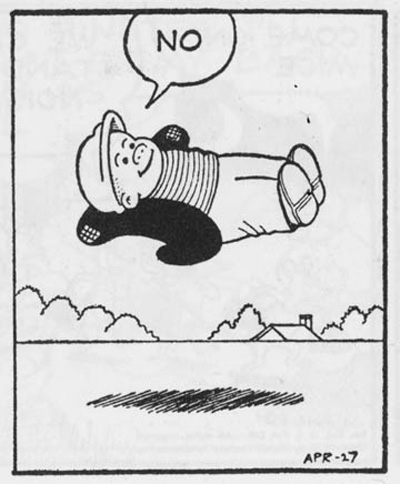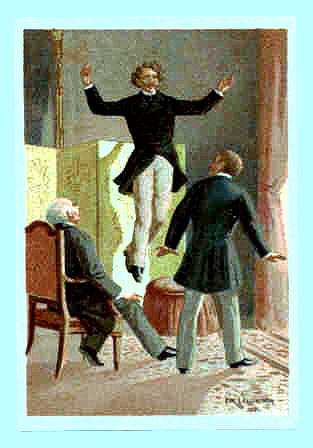
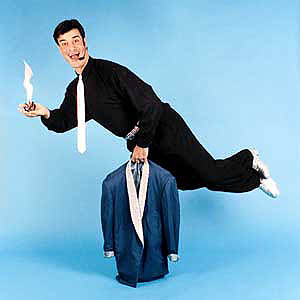
 |
 |
Ah, self-levitation! When magicians present this illusion it often wouldn't fool a child, as the image at the right above so well illustrates. But that's harsh reality, and the magician is actually doing something. Levitation is most impressive when entirely imaginary... Daniel Home did it in the 1880s (see image at left) and it was flawless, because it never happened. [Houdini discovered from interviewing the “eyewitnesses” to Home's feat that it occurred in total darkness and Home simply narrated what was supposed to be happening!] More recently such impossible levitations are generally confined to inaccessible spots on earth where various unwashed “Holy Men” or gurus levitate routinely every morning upon awakening... with nobody around, of course.
Magicians distinguish between levitations and suspensions, but this is a distinction in effect, not in method. In a suspension, some innocent-appearing item is in contact with the airborne holy man or magician's assistant... most often, in the US, a broom!... but the item is so far away from the suspended one's center of mass that the equally innocent spectator dismisses the possibility it is supporting the performer. The actual tourist-observable “levitations” performed in India by various gurus, swamis, fakirs and unwashed Holy Men are invariably suspensions, of the crudest and most primitive possible kind.
 |
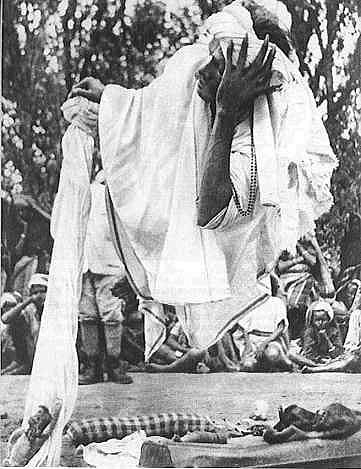 |
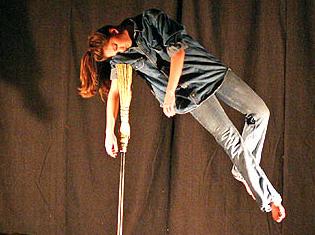 |
Properly presented, the broom suspension can be quite baffling. The performer walks out casually and brooms are inserted into his or her armpits like crutches. Then suddenly one broom is tossed aside, and the magician lifts the legs of the performer off the floor, leaving him or her suspended in the air, either at an angle or horizontally. To end the suspension, the process is simply reversed, and the performer walks off as casually as he or she walked on. Needless to say almost any stick-like object can be used in place of a broom. |
Turning to the so-called “levitation” illusions, there are two broad categories; we'll just call them, for now, type 1 and type 2. In the type 1 levitation, an assistant walks out and reclines on a bed or sofa. She is covered by a large cloth. Then, her form as outlined by the cloth is seen to rise vertically off the couch. In this type of levitation, the rise can be as large as the theater ceiling space permits, and the illusion ends with the magician stripping the cloth from the levitated figure to reveal that the figure has vanished into thin air! For historical reasons magicians tend to refer to this illusion as the Ashra levitation.
|
The other type of levitation, again for historical reasons, is usually called an Aga levitation. In this illusion, an assistant or the magician himself starts out in reclining or sitting or squatting position. In full view without covering the performer rises several feet into the air. There are many, many variants of the Aga levitation. In some versions the magician stands right behind the levitating assistant, and remains suspiciously motionless during the levitation. In other versions he stands well to the side, walking around freely. In both Ashra and Aga levitations, a large hoop can be passed over the levitated performer to make clear there are no “wires or supports.” This type 2 levitation is most impressive when done by the magician himself casually walking out, perching on a stool, and then levitating several feet above the stool with no visible support. The distance of rise in the Aga levitation is generally very severely limited, unlike the rise in the Ashra levitation. |
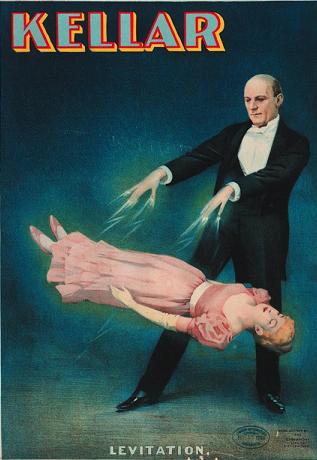 |
The ultimate form of levitation to date has been shown over the past decade by stage performers such as David Copperfield and Peter Marvey. In this illusion, originally developed by John Gaughan for an Orson Welles movie, but never used in films, the performer begins usually by laying on his back at center stage. He then rises up in Aga levitation style, but once in the air, everything changes. His body moves and turns freely, and he darts to all points of the stage, as if he is genuinely able to fly. In Marvey's variation, he can also fly out over the theater audience.
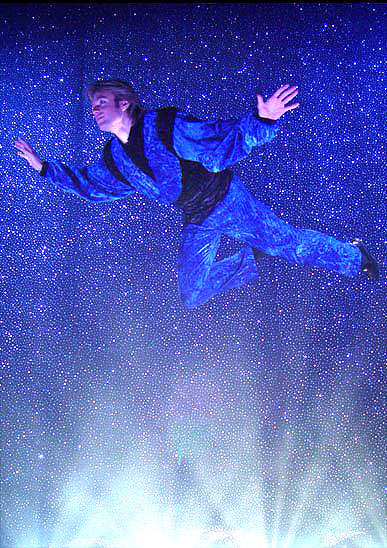
From the most impressive to the least impressive self-levitation—
Daniel Home was doing it in semidarkness in the early 1870s and
David Blaine made it famous
again on
a TV special some years ago. The performer stands with his two feet
close together and raises his
arms as if trying to maintain his balance (he is!). From just the right
angle, he is then seen to
rise until his feet are several inches above the floor. While this can
be a fooler in the right
circumstances, it generally disappoints audiences. It does have the
advantage of being entirely
or almost completely impromptu. If the performer does it in
semidarkness and wears black socks, as
Home did, it looks pretty good, but it can also be done, and usually is
done, in full light. [In his TV special Blaine performed the
standard version of this self-levitation for viewers on the street,
whose reactions were accurately recorded, but in reverse angle
shots the TV audience itself saw a deliberately unspectacular Aga
levitation, not the impromptu version at all.]
How would you characterize this modern magical feat... obviously a levitation, but with a refreshing lack of props.
